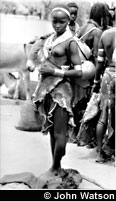


Photo credits to Tribalphoto.
Location: Ethiopia, Africa. They are primarily located in the Gemu Gofa province, which is east of the Omo River and north of Lake Turkana. This area, called the Lower Omo region, has remained one of the most inaccessible and least developed part of East Africa.
Population: 23,700.
Language: Hamer-Banna.
Neighboring Peoples: Hamer
Types of Art:
History: They belong to a group of culturally distinct people known as the Sidamo. Although they are racially mixed with the Bushmen hunters who originally inhabited the region, they do not have any Bushmen features. Authorities agree that they are clearly a mixture of the Caucasian and Negroid races.
Economy: Most of the Bana are cattle breeders.
Social Systems: They live in camps that consist of several related families. The families live in tents arranged in a circle, and the cattle are brought into the centre of the camp at night. When the campsite is being set up, beds for the women and young children are built first; then the tent frame is built around it. The tents are constructed with flexible poles set in the ground in a circular pattern. The poles are bent upward, joining at the top, then tied. The structures are covered with thatch during the dry season and canvas mats during the rainy season. Men and older boys usually sleep on cots in the centre of the camp, near the cattle.
Herds belonging to the Bana consist mainly of cattle, although there are some sheep and goats. Camels are used for riding and as pack animals. Most Bana plant fields of sorghum at the beginning of the rainy season before leaving on their annual nomadic journey. Some households also plant sesame and beans. Because the crops are usually left unattended, the yields are low. Few households grow enough grain to last through the year.
One striking characteristic of the Bana men is that they indulge in elaborate hair-dressing. They wear a clay "cap" that is painted and decorated with feathers and other ornaments. Much time is spent in preparing the hair, and care must be taken to protect it from damage. This is one reason the men often sleep on small, cushioned stools. A well-dressed man will wear a toga-like cloth and carry a spear and a stool. Women also commonly wear colourful toga-like garments.
Men may marry as many women as they like, but only within their own tribe. A "bride price" of cattle and other goods is provided by the prospective husband and his near relatives. A typical household consists of a woman, her children, and a male protector. A man may be the protector of more than one household, depending on the number of wives he has. Also, men are sometimes assigned the responsibility of protecting a divorced woman, a widow, or the wife of an absent husband (usually his brother). Marriage celebrations include feasting and dancing. Young girls as well as boys are circumcised.
Religion: The Bana are 90% Sunni Muslim. They observe the five basic teachings of Islam, which include acknowledging that Allah is the only god, praying, fasting, giving alms to the poor, and making a pilgrimage to Mecca.
However, many elements of their traditional religion are still practiced. For instance, they believe that natural objects (rocks, trees, etc.) have spirits. They also believe in jinnis, or spirits that are capable of
assuming human or animal form and exercising supernatural influence over people.
Credits: John Watson.
